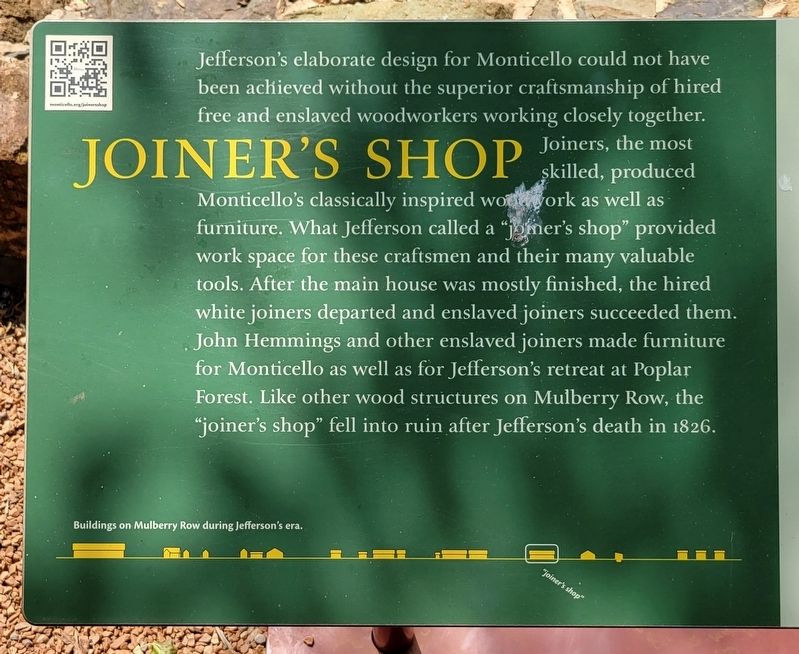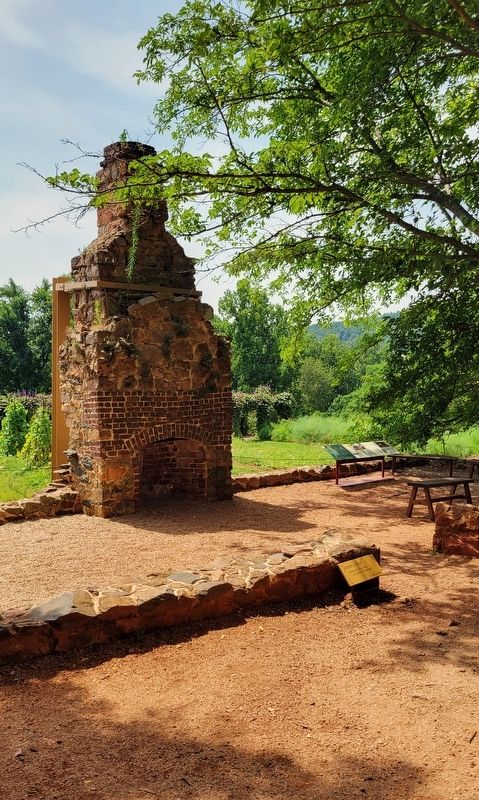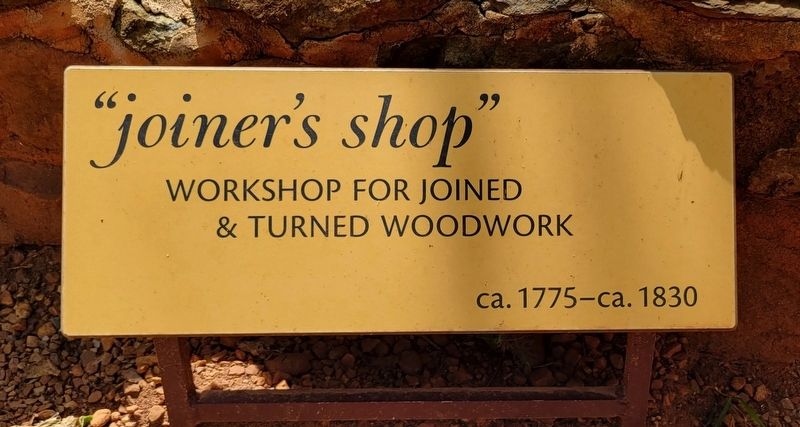Near Charlottesville in Albemarle County, Virginia — The American South (Mid-Atlantic)
Joiner's Shop
Jefferson's elaborate design for Monticello could not have been achieved without the superior craftsmanship of hired free and enslaved woodworkers working closely together. Joiners, the most skilled, produced Monticello's classically inspired woodwork as well as furniture. What Jefferson called a "joiner's shop" provided work space for these craftsmen and their many valuable tools. After the main house was mostly finished, the hired white joiners departed and enslaved joiners succeeded them. John Hemmings and other enslaved joiners made furniture for Monticello as well as for Jefferson's retreat at Poplar Forest. Like other wood structures on Mulberry Row, the "joiner's shop" fell into ruin after Jefferson's death in 1826.
Free Joiners
Skilled joiners were hard to find. Of the 18 free woodworkers Jefferson hired between 1770 and 1823, only five were joiners. Jefferson brought recent Irish immigrants James Dinsmore and John Neilson from Philadelphia-they proved to be the most talented of the hired joiners. At Monticello, they trained enslaved craftsmen and together made most of the woodwork in the house. Dinsmore and Neilson, with other carpenters and masons who worked at Monticello or the University of Virginia, went on to build some of the region's finest houses and public buildings.
a joiner's shop, 57 feet by 18 feet, the under pinning and chimney of stone, the roof of wood, one story high
Thomas Jefferson, 1796
Enslaved Joiners
Jefferson identified seven of his enslaved workers as carpenters. Besides their work on the house, they carried out much of the construction across the plantation-building fences and small log structures, splitting rails, and making shingles. John Hemmings and Lewis (last name unknown) became accomplished joiners. Lewis, who specialized in turning wood, produced all 212 neoclassical balusters encircling Monticello's roof. John Hemmings made furniture, produced the interior woodwork for Poplar Forest, and built the wooden body of Jefferson's landau carriage.
(Captions):
Jefferson's ca. 1776 plan for a joiner's shop, confirmed by archaeological and architectural evidence, informed the digital reconstruction of the "joiner's shop."
Massachusetts Historical Society
Archaeologists found this ruler at the "joiner's shop." Woodworking and making furniture require precise measurement, Joiners used rulers and other measuring devices for their craft.
Thomas Jefferson Foundation at Monticello
The Carpenter's Shop by John Hill, 1813. Early 19th-century carpenter shops were typically large, roughly finished rooms filled with workbenches, planes, hammers, saws, augers, chisels, and other woodworking tools.
Tate Gallery
Dumbwaiters held soiled and clean plates, food, and drink in Jefferson's dining rooms after he returned from France. The dumbwaiters Jefferson ordered in Philadelphia in the early 1790s inspired this walnut example attributed to John Hemmings.
Thomas Jefferson Foundation at Monticello
Lewis turned this black locust baluster by using the "great wheel" lathe in the "joiner's shop" around 1808. It was one of hundreds he made for Monticello II.
Thomas Jefferson Foundation at Monticello
Topics and series. This historical marker is listed in these topic lists: African Americans • Industry & Commerce. In addition, it is included in the Former U.S. Presidents: #03 Thomas Jefferson series list. A significant historical year for this entry is 1826.
Location. 38° 0.544′ N, 78° 27.216′ W. Marker is near Charlottesville, Virginia, in Albemarle County. Marker can be reached from Monticello Loop, 0.4 miles north of Thomas Jefferson Parkway (Virginia Route 53), on the left when traveling north. The marker is along Mulberry Row heading west from Monticello towards the Monticello Graveyard. Touch for map. Marker is at or near this postal address: 931 Thomas Jefferson Parkway, Charlottesville VA 22902, United States of America. Touch for directions.
Other nearby markers. At least 8 other markers are within walking distance of this marker. Wood Trades (a few steps from this marker); Nail-Making (within shouting distance of this marker); Nursery (within shouting distance of this marker); Contemplative Site (within shouting distance of this marker); Discovering Mulberry Row (within shouting distance of this marker); Charcoal (about 300 feet away, measured in a direct line); Forge & Quarters (about 300 feet away); The Levy Legacy (about 300 feet away). Touch for a list and map of all markers in Charlottesville.
Credits. This page was last revised on August 19, 2023. It was originally submitted on August 17, 2023, by Bradley Owen of Morgantown, West Virginia. This page has been viewed 79 times since then and 29 times this year. Photos: 1, 2, 3, 4. submitted on August 17, 2023, by Bradley Owen of Morgantown, West Virginia.



